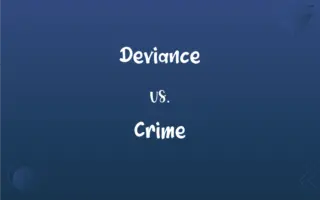DNA vs. Chromosome: What's the Difference?
Edited by Janet White || By Harlon Moss || Published on November 30, 2023
DNA is the molecule carrying genetic instructions, while a chromosome is a structure containing DNA and proteins, organizing genetic information.

Key Differences
DNA (Deoxyribonucleic acid) is a long molecule that contains our unique genetic code. However, a chromosome is a packaged form of DNA, combined with proteins, found in the nucleus of our cells.
The structure of DNA is a double helix formed by base pairs attached to a sugar-phosphate backbone. While, chromosomes are made of DNA coiled tightly around proteins called histones.
DNA contains the instructions needed for an organism to develop, survive, and reproduce. Whereas, chromosomes ensure DNA is accurately replicated and distributed in cell division.
Humans have 23 pairs of chromosomes in each cell, which contain all the DNA necessary for the functioning of the body. Each chromosome carries many genes, the basic units of heredity.
DNA sequences must be read accurately to produce proteins, which are essential for life. The integrity of these sequences is maintained within the structure of the
ADVERTISEMENT
Comparison Chart
Definition
A molecule with genetic instructions
A structure containing DNA and proteins
Structure
Double helix with base pairs
DNA coiled around histones
Role
Carries genetic information
Organizes and protects genetic information
Unit of Heredity
Contains genes
Carries many genes
In Cells
Found in chromosomes
Found in cell nucleus
ADVERTISEMENT
DNA and Chromosome Definitions
DNA
DNA is the carrier of genetic information in living organisms.
DNA testing can reveal family ancestry.
Chromosome
Chromosomes vary in number across different species.
Fruit flies have four pairs of chromosomes.
DNA
DNA sequences are essential for synthesizing proteins.
Errors in DNA can lead to genetic disorders.
Chromosome
Abnormalities in chromosomes can lead to genetic disorders.
Abnormal chromosome count can result in developmental issues.
DNA
DNA has a unique double helix structure.
The discovery of DNA's structure revolutionized biology.
Chromosome
Chromosomes are structures that organize DNA within cells.
Humans typically have 23 pairs of chromosomes.
DNA
DNA replication is crucial for cell division.
During mitosis, DNA is replicated in each new cell.
Chromosome
Chromosomes ensure proper distribution of genetic material during cell division.
Chromosomes align during metaphase of mitosis.
DNA
DNA mutations can lead to evolutionary changes.
Some DNA mutations can confer survival advantages.
Chromosome
Each chromosome carries many genes.
The 21st chromosome's trisomy causes Down syndrome.
DNA
A nucleic acid that carries the genetic information in cells and some viruses, consisting of two long chains of nucleotides twisted into a double helix and joined by hydrogen bonds between the complementary bases adenine and thymine or cytosine and guanine. DNA sequences are replicated by the cell prior to cell division and may include genes, intergenic spacers, and regions that bind to regulatory proteins.
Chromosome
A linear strand of DNA and associated proteins in the nucleus of eukaryotic cells that carries the genes and functions in the transmission of hereditary information.
DNA
Alternative form of DNA
Chromosome
A circular strand of DNA in bacteria and archaea that contains the hereditary information necessary for cell life.
DNA
Abbreviation for deoxyribonucleic acid; - more commonly used than the full name. See also RNA.
Chromosome
A linear arrangement of condensed DNA and associated proteins (such as chaperone proteins) which contains the genetic material (genome) of an organism.
Chromosomes store genetic information.
DNA
(biochemistry) a long linear polymer found in the nucleus of a cell and formed from nucleotides and shaped like a double helix; associated with the transmission of genetic information;
DNA is the king of molecules
Chromosome
One of the minute bodies into which the chromatin of the nucleus is resolved during mitotic cell division; the idant of Weismann.
Chromosome
A threadlike body in the cell nucleus that carries the genes in a linear order
FAQs
What makes up chromosomes?
DNA coiled around histone proteins.
What is DNA?
Molecule carrying genetic instructions in cells.
Are DNA and chromosomes the same?
No, DNA is part of chromosomes.
Can chromosome number vary in species?
Yes, different species have different numbers of chromosomes.
Is DNA found in all living organisms?
Yes, in some form in all organisms.
How is DNA structured?
As a double helix with base pairs.
How many chromosomes do humans have?
23 pairs in each cell.
What role do chromosomes play in heredity?
They carry genes, the units of heredity.
What happens if chromosome structure is altered?
It can lead to genetic disorders or diseases.
What is a chromosome?
Structure in cells containing DNA and proteins.
What is the primary role of DNA?
To store and transmit genetic information.
What is chromosomal trisomy?
The presence of an extra chromosome.
How does DNA affect protein synthesis?
DNA sequences are used to build proteins.
What function do chromosomes serve?
Organizing and protecting genetic material.
How do DNA mutations affect organisms?
They can lead to genetic variations or disorders.
Can DNA be used for identification?
Yes, due to its unique pattern in individuals.
How is DNA replicated?
Through a process in cell division.
Can environmental factors affect DNA?
Yes, they can cause mutations.
What are histones in chromosomes?
Proteins around which DNA coils.
How are DNA and chromosomes related?
Chromosomes are the structural units containing DNA.
About Author
Written by
Harlon MossHarlon is a seasoned quality moderator and accomplished content writer for Difference Wiki. An alumnus of the prestigious University of California, he earned his degree in Computer Science. Leveraging his academic background, Harlon brings a meticulous and informed perspective to his work, ensuring content accuracy and excellence.
Edited by
Janet WhiteJanet White has been an esteemed writer and blogger for Difference Wiki. Holding a Master's degree in Science and Medical Journalism from the prestigious Boston University, she has consistently demonstrated her expertise and passion for her field. When she's not immersed in her work, Janet relishes her time exercising, delving into a good book, and cherishing moments with friends and family.































































